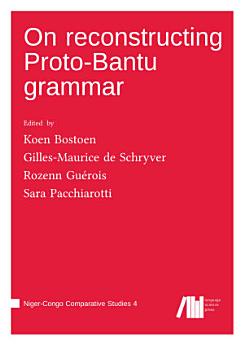On reconstructing Proto-Bantu grammar
Über dieses E-Book
Autoren-Profil
Koen Bostoen (°1975) has been a professor of African Linguistics and Swahili at Ghent University since 2011. Before he was a researcher at the Université libre de Bruxelles, where he obtained his PhD degree in 2004, and at the Royal Museum for Central Africa in Tervuren. His research focuses on the historical-comparative study of Bantu languages and on interdisciplinary approaches to the African past. He obtained an ERC Starting Grant for the KongoKing project (2012-2016) and an ERC Consolidator’s Grant for the BantuFirst project (2018-2022). Amongst others, he is the author of Des mots et des pots en bantou: une approche linguistique de l’histoire de la céramique en Afrique (2005, Peter Lang) and co-editor of Studies in African Comparative Linguistics, with Special Focus on Bantu and Mande (2005, RMCA), The Kongo Kingdom: Origins, Dynamics and Cosmopolitan Culture of an African Polity (2018, Cambridge University Press), Une archéologie des provinces septentrionales du royaume Kongo (2018, Archaeopress) and The Bantu Languages, 2nd edition (2019, Taylor and Francis).
Gilles-Maurice de Schryver (°1971) has been research professor of African Linguistics at Ghent University since 2015, and extraordinary professor at the University of Pretoria since 2014. He holds an MSc in Microelectronic Engineering (1995), as well as an MA (1999) and PhD (2005) in African Languages and Cultures. In 2002 he co-founded TshwaneDJe HLT to develop lexicographic software, and in 2006 he was a founding member of the African Language Technology group. He is the author or co-author of close to 400 books, book chapters, journal articles and conference papers, mainly on Bantu corpus linguistics and lexicography in general. His publications also include award-winning dictionaries for Northern Sotho, Zulu and Xhosa, published with Oxford University Press, as well as various online dictionaries, amongst others the most popular one for Swahili. He is a two-term past President of Afrilex (2009-2013), and past President of Euralex (2018-2021). Earlier, he also served in other capacities on the executive boards of Afrilex (2001-2009), Euralex (2006-2014), Asialex (2007-2013) and Australex (2008-2013). Most recently, he has been co-facilitating the creation of Americalex (2021), and currently sits on the board of Globalex (2022).
Rozenn Guérois (°1985) is a researcher at the laboratory LLACAN (Langage, Langues et Cultures d’Afrique) of the French National Centre for Scientific Research (CNRS), and an affiliated researcher at the Department of Linguistics of the University of KwaZulu-Natal (UKZN). She received her PhD from the University of Lyon 2 in 2015. Before joining the CNRS in 2020, she was a postdoctoral researcher at SOAS University of London (2015-2018) and Ghent University (2018-2020). Her research interests include the description of Bantu languages spoken in Mozambique, morphosyntactic variation, typology, and comparative and historical linguistics. She has recently obtained an ANR Grant (French National Research Agency) for the OriKunda project (2023-2027). Since 2020, she has been a member of the committee of the journal Linguistique et Langues Africaines (LLA).
Sara Pacchiarotti (°1982) obtained her PhD in Linguistics from the University of Oregon in 2017 under Fulbright sponsorship. She was a postdoctoral researcher within the BantuFirst project until the end of October 2020, where she focused on historical comparative research on West-Coastal Bantu languages. She is currently carrying out an FWO-funded postdoctoral project on morphological reconstruction and morphosyntactic change in West-Coastal Bantu. She is passionate about historical linguistics and diachronic language change in general. She is the author of Bantu applicative constructions (CSLI, 2020) and co-editor of Applicative morphology: neglected syntactic and non-syntactic functions (de Gruyter, 2022) and Diversity in African Languages: Selected papers from the 46th Annual Conference on African Linguistics (Language Science Press, 2016). Besides West-Coastal Bantu languages spoken in the homeland of the branch such as Ngwi B861 [nlo], she has worked on the eastern Bantu languages Tswana [tsn] and Rundi [run], as well as Bribri [bzd] (Chibchan, Costa Rica), and Mooré [mos] (Gur, Burkina Faso).








